Hobby Lobby Home Decor Star Trek
Star Trek: The Next Generation is 34 years old this year. It debuted three years after the Apple Macintosh, long before we had smartphones or tablets. And yet, if you watch an episode today, the USS Enterprise looks as futuristic as ever. That's thanks largely to the set design, full of rounded rooms that flow seamlessly into the strange and soft furnishings. It's as if society is so advanced, the technology recedes completely to comfort.
But in fact, these furnishings—the chairs in particular—were off-the-shelf designs. Sometimes they were painted, or modified to look future-y with buttons and lights. But more often than not, they were pulled from a designer storeroom and placed straight into the 23rd century.

And for the past several years, a team of Star Trek fans and artists has been meticulously identifying every chair across the Star Trek universe. You can check their ongoing spreadsheet here to see what they've identified so far. It includes a range of quirky, famous chairs, and the even more famous designers and architects behind them—from the blooming plastics of the Finnish-American architect Eero Saarinen, to the impossibly inviting upholstery of Charles and Ray Eames, to the organic curves of French architect Charlotte Perriand, to the plush ergonomics of Norwegian designer Peter Opsvik.
The hunt begins
Many of the efforts are led by Tadeo D'Oria, a 3D artist in Buenos Aires. A Star Trek fan all his life, he taught himself 3D modeling software at the age of 14 in order to design his own ships, and he began posting his work on sci-fi forums. By the time he was 23, in 2016, D'Oria found himself trapped in a dead-end job and decided to pursue his passion.
"One thing led to another and, thanks to the small popularity I gained in those online forums, I was able to make a living as a freelance 3D artist," he writes over email, "specializing in doing digital Star Trek interiors for clients who had their own fan ships and stories."

That's right: He became a full-time, commissioned designer for bespoke Star Trek creations that fans use to illustrate their own Star Trek fiction or visualize a Star Trek role-playing game. His work starts at $50 and can go over $500, depending on what his clients want. Star Trek renderings represent 90% of his work as a 3D artist to this day.
To create authentic-looking Star Trek spaces, D'Oria began building a database of the props and sets across Star Trek movies and shows. That included tracking down a lot of chairs, figuring out the make and model, and then attempting to find PDFs with brochures that would include full sizing schematics so he could recreate them.
"I certainly wasn't alone nor the first one interested in this sort of thing. Other fans had already identified several of the chairs used through the series (mostly the original '60s show) and even created replicas," writes D'Oria. "However because of my job doing essentially 3D reproductions of these chairs, having information about them was invaluable to me in order to work faster."
In 2017, D'Oria even joined a team of fan volunteers to launch Stage 9, a video game that allowed you to explore the fully recreated USS Enterprise interior from The Next Generation. That work only pushed D'Oria's obsession with Star Trek furniture further.
While CBS shut the game down, he had this rich collection of research that he didn't want to see go to waste; he wanted to share it with others in the Star Trek modeling community. So he worked with Bernd Schneider, who runs the popular Star Trek site Ex Astris Scientia (the Starfleet Academy motto, which translates as "From the stars, knowledge"), to host the database and assist with research.
Unpacking our obsession with Saarinen
D'Oria now has the distinction of being, perhaps, the world's leading expert on Star Trek chairs. While he doesn't collect the chairs himself, he's given a lot of thought to what chairs bring to sci-fi.
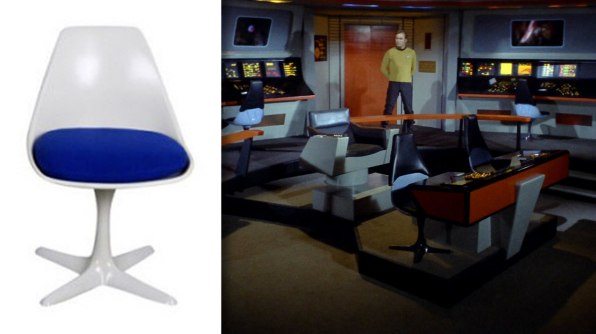
Eero Saarinen produced furniture that was used in the 1960s on both Star Trek and Stanley Kubrick's 2001: A Space Odyssey. In Star Trek, two variations of his plastic Tulip chair were commonly used; Saarinen originally designed it for Knoll in 1957. The Tulip was radical for its time, trading the four legs that defined chairs for centuries with a bottom that was more like the stem of a wine glass. The chair used a mixture of cast aluminum and fiberglass (reinforced plastic) to create a structure that almost looks too delicate to sit in.
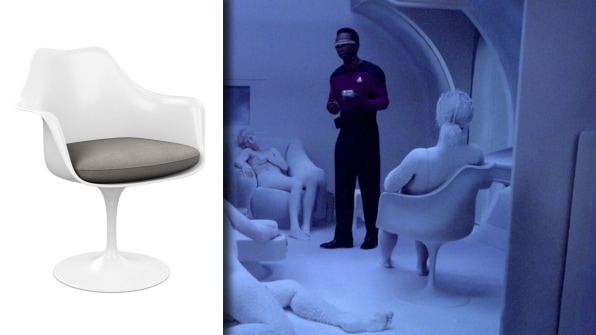
"As for Saarinen's designs in particular, they were very much indicative of the 'cutting edge' for the era of the original Star Trek series, due to their use of plastic, which at the time was seen as the material of the future," writes D'Oria. "Their simple yet organic shape would've been impossible to manufacture just a few decades before."
Truthfully, that space-age feel of Saarinen's work never really went away. The world is still obsessed with Saarinen's TWA Flight Center at JFK airport, which reopened as a hotel in 2019 following a $265 million renovation.
D'Oria has another theory as to why Saarinen's work fits a utopian future so perfectly. He traces the design sensibility of Star Trek back to Matt Jeffries, who designed the original Enterprise ship for Star Trek.
"[Jeffries] gave it a clear, flat outer hull because he envisioned the craft as so utterly advanced that there was no need for exposed machinery. You were free to imagine all the wonders of technology running underneath that hull, yet they were so perfect and worked so well that nothing needed to be exposed or visible," writes D'Oria. "The same kind of imaginative world-building is possible with the simple Saarinen chairs. Sure, they look less useful than even the cheapest of office chairs today, but place them in a sci-fi setting, and maybe under those clear panels there's a computer that can make instant adjustments to the chair when someone sits to make it more comfortable to them in particular."
Fast-forward 20 years into the future of television, or a century in the universe of Star Trek, and we end up at the USS Enterprise as we see it on Star Trek: The Next Generation (TNG).
"For TNG, being the late '80s and early '90s, all that plastic got replaced with fabric, but the same mentality remained," writes D'Oria. "You can't see any mechanism in these chairs, thus you're free to imagine they're very advanced underneath all that."
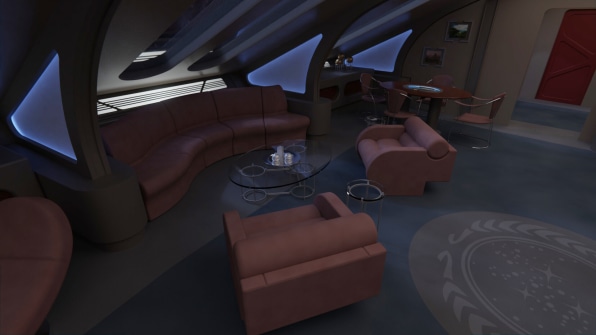
Popular TNG chairs challenged what chairs should look like. Designer Steve Leonard created a dining chair for Brayton in the 1970s, which resembles a single bolt of fabric, unrolled and given shape, for Data's quarters (these chairs sell for thousands of dollars today). Others mirrored furniture design of the 1980s, which began to accommodate human bodies that were spending increasing hours sitting in front of computers with a focus on ergonomics. The HÅG Anova 2030 is just this. By the Norwegian designer Peter Opsvik, it's essentially a posh task chair, with a back that appears to float from its base, and it was used frequently on Star Trek sets.
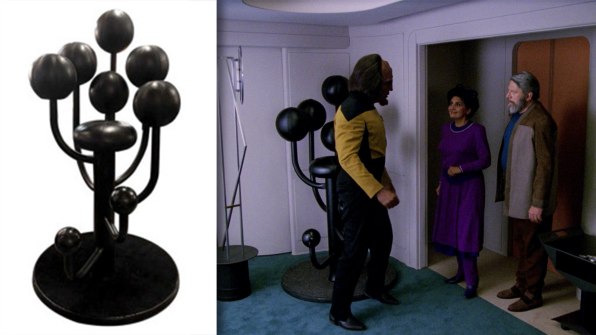
The wildest Opsvik design in Star Trek may be his Stokke Globe Garden, which is distinguished by its branching, mushroom-like design. In one unintentionally hilarious scene with the Enterprise's Klingon security officer, Worf, he sits on this chair, like a quirky throne in an otherwise empty room. His parents come to visit and have to look up to him, sitting in this tall chair for no reason, while standing in the doorway. It's a chef's kiss of awkwardness.
But some of the HÅG models used into the '90s Star Trek began looking downright domestic. Normal. They were borderline the type of chair you might grab at an Office Depot.
"Logically, as the years rolled on and what was commercially available changed, the chairs we saw in Trek changed as well," says D'Oria, "with desk office chairs becoming more and more prevalent as those designs flooded the market and became cheaper alongside household PCs." In my opinion, these chairs don't look entirely out of place, but they don't do nearly as much work to set the scene of a future utopia as earlier choices.
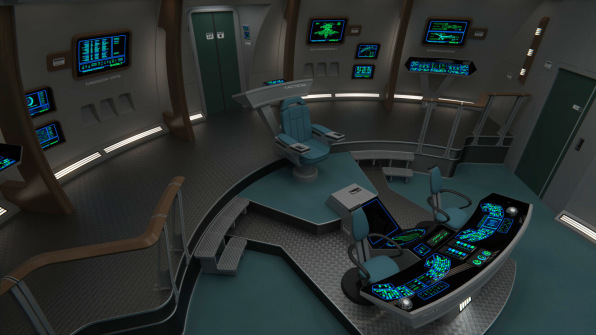
Finding the favorite chair
Of all of D'Oria's findings, he does have a favorite Star Trek chair. He believes it's quite possibly the most used chair in Star Trek, having appeared in several movies and shows. And it's a chair he only tracked down last year, with the help of a patient museum curator, with COVID-19 in full swing. (The saga, which you can read here, is truly incredible).
As for the chair itself, it is the Ergoform Workseat, which looks like if you took an '80s desk chair, sliced it up, and glued the disembodied seat and backrest onto a single slab of metal.
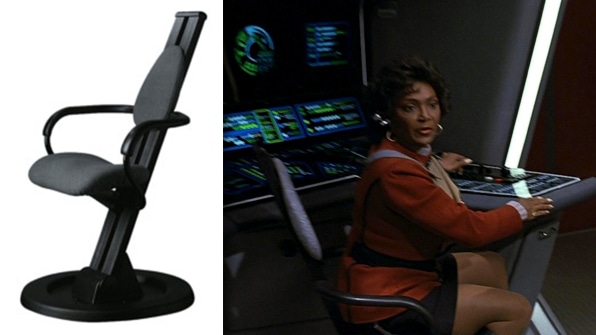
Frankly, the Workseat looks almost nonsensical, like someone did some truly terrible things to a Bowflex. But when an actor is seated, the padding almost disappears, and the camera only catches that minimal, metal spine that holds the chair together. Again, that spartan design lets your mind imagine something more technologically sophisticated happening under the hood, capturing the intent of the original Star Trek ship designer, Matt Jeffries.
Despite his accomplishment in tracking down the Workseat, D'Oria's work in identifying the chairs of Star Trek continues. His list of the unidentified chairs across Star Trek may be longer than the identified ones! If you are interested in the project, and have an eye for furniture, his collaborators could use help.
"It was my idea to compile this list, but at this point, I think more than half the chairs on [the] list were identified by other people," says D'Oria. "So if anything, this is a small testament to Star Trek's core message, that if we work together, we can do far more than we can do on our own."
Hobby Lobby Home Decor Star Trek
Source: https://www.fastcompany.com/90619500/see-the-unexpectedly-sophisticated-chairs-of-star-trek-from-eames-to-perriand-to-saarinen